The 5¼" drive and floppy disk....
Obsoletus Instrumentum - The 5¼" drive and floppy disk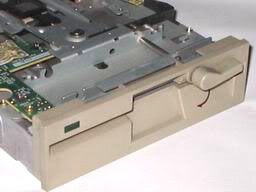 During the 80s up to the middle of the 90s, 5¼" disk drives and minifloppy disks were as common as CD-ROM drives and CD-ROMs are today. Not that there was much choice. In the early days only high-end PCs had hard drives, if at all, and optical drives were still some ways off in the future. However, you may be surprised to know that the floppy drive and its disks were actually invented in the late 60s and introduced way back in 1971 by IBM. Then, they were referred to as "memory disks."
During the 80s up to the middle of the 90s, 5¼" disk drives and minifloppy disks were as common as CD-ROM drives and CD-ROMs are today. Not that there was much choice. In the early days only high-end PCs had hard drives, if at all, and optical drives were still some ways off in the future. However, you may be surprised to know that the floppy drive and its disks were actually invented in the late 60s and introduced way back in 1971 by IBM. Then, they were referred to as "memory disks."
The technology was developed by a team of IBM engineers led by Alan Shugart, who is often acknowledged to be its inventor. The first floppy disks consisted of a soft, "floppy" plastic disk measuring 8" in diameter coated with iron oxide and enclosed in a thin plastic protective envelope. The envelope had a hole in the center for the drive's hub-clamping mechanism, a rectangular hole with rounded ends for the read/write mechanism, and a small round hole used for timing purposes. It had capacities which ranged from 256 KB, to 512 KB, to 1.2 MB.
In 1976, the 5¼" floppy drive and floppy disk (known as the "minifloppy" as it was a smaller version of the original 8" disk) was developed by Alan Shugart for Wang Laboratories. Aside from being physically smaller, it added a feature not found in the 8" variety - a write protect notch.
A plethora of drive manufacturers made the drive and its disks common, adopted by pioneers and major players in the fledgling PC industry. Apple used it for its revolutionary Apple II family in 1978 and IBM for its industry defining IBM PC in 1981. The myriad manufacturers of CP/M based microcomputers also adopted it as standard, making it the most common computer storage medium during the 80s. Storage capacities for IBM format disks ranged from 160 KB to 1.2 MB with the high-density specification launched in 1984 with the IBM PC AT. The most common formats were had capacities of 360 KB (double-sided, double-density) and 1.2 MB (double-sided, high-density).

A fully functional late model 5¼" TEAC 1.2 MB high density drive, circa 1995. It could also read and write to lower capacity 360 KB disks, though sometimes a 360 KB disk formatted and written to by a 1.2 MB drive had incompatibilities when read in a 360 KB drive.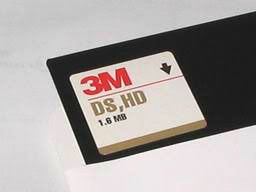
High density minifloppy disk with a formatted capacity of 1.2 MB.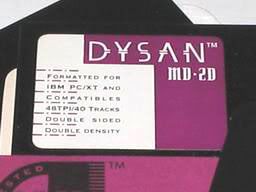
Double density minifloppy disk with a formatted capacity of 360 KB.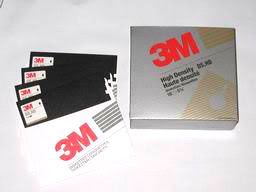
High density minifloppies.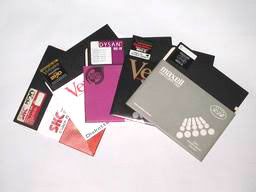
Assorted double density minifloppy disks.
The 3½" floppy drive and disk specification (this time referred to as a "microfloppy") was introduced in 1981, and within a matter of years drove the 5¼" drive and media to obsolescence and subsequent extinction. This form factor was popularized by the Apple Macintosh in 1984 and the IBM PS/2 in 1987. High density versions of this drive and its disks still live on even in contemporary computers.
Despite being outclassed by higher capacity media such as Zip drives and recordable and rewritable optical media, it seems that the floppy drive, regardless of physical size, is just too useful to ever go away for good. It seems a safe bet to say that we haven't seen the last of the floppy drive.
And what ever happened to Alan Shugart? After he left IBM he founded Shugart Associates, a manufacturer of computer peripherals. After a couple of years he left and founded another company, Shugart Technologies. It later changed its name to Seagate Technology, and is currently known as a major manufacturer of hard disk drives.
Trivia:
The first 5¼" floppy drive was the SA-400 introduced in 1976. It had a capacity of 110 KB.
SCSI (Small Computer Systems Interface) was originally referred to as SASI (Shugart Associates Systems Interface). SCSI is the interface of choice when it comes to high-performance storage requirements, such as servers.
Earlier in this series:
The Pentium and Pentium MMX....
The Sound Blaster 16....
Comments
Tried an P2 adapter using the modern house, but could not make it work. Any ideas on how to make it work?
Also have scores of software/files on the old floppies.
If all you need is functioning adapter, I've noticed a couple of auctions on eBay hawking Apple IIc power supplies. You may want to check them out.
Here are a few I found:
APPLE IIC POWER SUPPLY TESTED OEM CLEAN AC ADAPTER
Apple IIc Computer Power Supply AC Adapter A2M4017
Hope this helps, and you can get your Apple running again.
Had an Apple II Plus several years ago, suffered a burned out power supply, couldn't find any replacement parts anymore. What a shame. Also have tons of floppies with all sorts of Apple II program.
The unit works fine, except for the use of a mouse.
Ergo, maybe I should search for the older mouse.
Anyway, no big deal. Thanks for the info.
I saw this on eBay:
Apple IIc Mouse with Mouse Paint llc. Seems like a good deal at 5 bucks for a never been used unit. :-)
Thanks for visiting. :-)